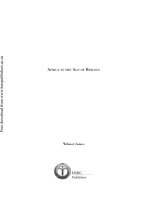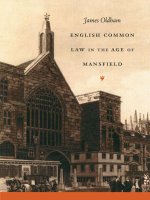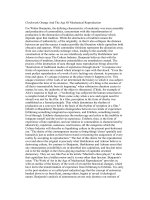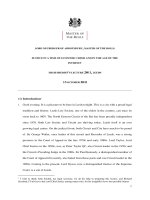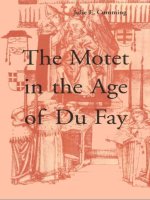the motet in the age of du fay
Bạn đang xem bản rút gọn của tài liệu. Xem và tải ngay bản đầy đủ của tài liệu tại đây (2.53 MB, 431 trang )
The Motet in the Age of Du Fay
During the lifetime of Guillaume Du Fay (c. 1400–1474) the motet
underwent a profound transformation. Because of the protean nature
of the motet during this period, problems of definition have always
stood in the way of a full understanding of this crucial shift. Through
a comprehensive survey of the surviving repertory, Julie Cumming
shows that the motet is best understood on the level of the subgenre.
She employs new ideas about categories taken from cognitive psy-
chology and evolutionary theory to illuminate the process by which
the subgenres of the motet arose and evolved. One important finding
is the nature and extent of the crucial role that English music played
in the genre’s transformation. Cumming provides a close reading of
many little-known pieces; she also shows how Du Fay’s motets were
the product of sophisticated experimentation with generic bound-
aries.
. is Associate Professor of Music at McGill
University, Montreal.
The Motet in the Age of Du Fay
Julie E. Cumming
The Pitt Building, Trumpington Street, Cambridge, United Kingdom
The Edinburgh Building, Cambridge CB2 2RU, UK
40 West 20th Street, New York, NY 10011-4211, USA
477 Williamstown Road, Port Melbourne, VIC 3207, Australia
Ruiz de Alarcón 13, 28014 Madrid, Spain
Dock House, The Waterfront, Cape Town 8001, South Africa
First published in printed format
ISBN 0-521-47377-2 hardback
ISBN 0-521-54337-1
p
a
p
erback
ISBN 0-511-03782-1 eBook
Cambrid
g
e University Press 2004
1999
(Adobe Reader)
©
Contents
List of tables page vii
List of musical examples ix
Acknowledgments xi
Notes to the reader xiii
Introduction 1
Part I Models and methods 5
1 Approaches and analogies 7
2 Subgenre, interpretation, and the generic repertory 24
3 Fifteenth-century uses of the term “motet” 41
Part II Motets in the early fifteenth century:
the case of Bologna Q15 63
4 The motet section of Bologna Q15 and its ramifying roots 65
5 A new hybrid subgenre: the cut-circle motet 99
6 Other new hybrid subgenres 125
7 The motet in the early fifteenth century: evolution and
interpretation 147
Part III Motets in the mid-fifteenth century:
the case of the Trent Codices 165
8 Motets in the Trent Codices: establishing the boundaries 167
v
9 English and continental cantilena-style motets 185
10 Motets with a tenor cantus firmus c. 1430–1450 206
11 Freely composed four-voice writing in transition 228
12 The four-voice motet c. 1450–1475 254
Conclusion 288
Appendix: Widely disseminated motets 304
Notes 306
Bibliography of books and articles 357
Modern editions of music 374
Sources and sigla 379
Notes on the index of works 382
Abbreviations for subgenre identi fications 382
Index of works 384
General index 400
Contents
vi
Tables
12.1 Relative voice ranges for the motet and their generic
associations pages 30
13.1 Settings of antiphon texts in Modena X.1.11 50
13.2 Fifteenth-century manuscripts containing more than five motets 56–7
14.1 Subgenres of the motet in Bologna Q15 69
14.2 Italian motets in Q15 72–3
14.3 Subjects of motet texts from fourteenth-century Italy (before
Ciconia) 81
14.4 French isorhythmic motets in Q15 83–4
14.5 Subjects of Latin-texted motets from fourteenth-century France 85
14.6 English cantilenas in Q15 86
14.7 Motets and cantilenas in the Old Hall Manuscript 89
15.1 Cut-circle motets in Q15 110–11
15.2 Three related works by Du Fay 120
16.1 Declamation motets in Q15 126
16.2 Continental cantilenas in Q15 131
16.3 Unus–chorus motets in Q15 133
16.4 Retrospective double-discantus motets in Q15 135
16.5 Devotional double-discantus motets in Q15 139
16.6 Other double-discantus motets in Q15 142
16.7 Borderline motets in Q15 143
16.8 Song of Songs settings in Q15 145
17.1 Representation of the Q15 subgenres in other contemporary
manuscripts 149
18.1 Dates and provenance for the Trent Codices 168
vii
18.2 Liturgical genres in the Trent Codices 173
18.3 Cantiones and Leisen in the Trent Codices 175
18.4 Secular contrafacta in the Trent Codices 178–9
18.5 Sacred contrafacta in the Trent Codices 180
18.6 Subgenres of the motet in the Trent Codices and Modena X.1.11 182
19.1 English cantilenas in the Trent Codices and Modena X.1.11 187–9
19.2 Three-voice continental cantilena-style motets in the Trent
Codices and Modena X.1.11 196–7
10.1 Four-voice isorhythmic motets in the Trent Codices and Modena
X.1.11 with triplum and motetus voices in the same range 207
10.2 Four-voice isorhythmic motets with unequal triplum and motetus 209
10.3 Three-voice tenor motets 216
11.1 Double-discantus motets copied in mid-century 229
11.2 Transitional four-voice non-isorhythmic motets with a single
discantus 232
11.3 Constructing a four-voice texture 247
12.1 Four-voice song motets 255
12.2 Tenor motets 258–9
12.3 Chant-paraphrase motets 267
12.4 Hybrids of the tenor and chant-paraphrase motets 271
12.5 Freely composed motets 279
C.1 Subgenres, with their antecedents and descendants 298–301
C.2 Genres outside the motet that influenced the motet 302
C.3 Map of motet subgenres and other related genres over time 303
List of tables
viii
Musical examples
14.1 Cristoforus de Monte, Dominicus a dono pages 74–5
14.2 Cadence types in three and four voices 76
14.3 John Forest, Alma redemptoris mater 92–3
15.1 Johannes de Sarto, Ave mater, O Maria 106–7
15.2 Characteristic opening for cut-circle motets with F and C finals 112–13
15.3 Florid melismas in cut-circle motets 114
15.4 Repeated-note figure in imitation in cut-circle motets 116
15.5 Power, Salve regina, opening, mm. 1–21 123
16.1 Arnold de Lantins, Tota pulchra es 128–9
16.2 Salinis, Ihesu salvator seculi 137
16.3 Lymburgia, cadences from Tota pulchra es 140
19.1 Du Fay, Alma redemptoris II, mm. 18–26 198
19.2 Du Fay, Ave regina celorum II, mm. 62–81 199
19.3 Touront, Compangant omnes 203-4
10.1 Contrasting introitus sections 210
10.2 Dunstaple, Veni/Veni, mm. 121–35 211
10.3 Sarto, Romanorum rex, mm. 25–35 214
10.4 Anon., Regali ex progenie/T: Sancta Maria 218–19
11.1 Du Fay, O proles/O sidus, mm. 79–83 234
11.2 Du Fay, O proles/O sidus, mm. 14–26 235
11.3 Anon., O pulcherrima, mm. 1–24, three- and four-voice versions 238
11.4 Anon., Anima mea, mm. 7–21, three- and four-voice versions 240
11.5 Puyllois, Flos de spina 241-3
11.6 Du Fay, Ave regina celorum III, mm. 138–49 246
11.7 Anon., Missa Caput, Kyrie, mm. 117–33 250
ix
12.1 Anon., Perpulchra Sion filia, tenor 266
12.2 Touront, Recordare, mm. 1–14 268
12.3 Touront, Recordare, mm. 30–53 269
12.4 Anon., Regina celi, mm. 44–50 270
12.5 Anon., Ave beatissima, mm. 55–152 272–3
12.6 Anon., Vidi speciosam, secunda pars 275
12.7 Anon., Gaude regina, mm. 50–4 283
List of music examples
x
Acknowledgments
My initial debt is to my teachers – Richard Taruskin, Richard Crocker,
Daniel Heartz, Anthony Newcomb, and Joseph Kerman. Something from
each of them is in this book. Thanks to Laurence Dreyfus, who helped me
start thinking about genre and told me to read Alastair Fowler. Some of the
ideas in chapter 3 were first developed in a seminar with James Haar at
Berkeley in 1983. Early drafts of material in the book were presented at
National Meetings of the American Musicological Society (Oakland 1990,
Pittsburgh 1992, and New York 1995); at Wellesley College, June 1993; and at
the 27th International Congress on Medieval Studies, Kalamazoo, Michigan,
May 1992. I have received helpful comments on early versions of portions of
this book from Michael Allsen, Margaret Bent, David Fallows, Richard
Taruskin, and Rob Wegman. Michael Allsen graciously sent me a copy of his
dissertation, an invaluable aid to my research. Joshua Rifkin and Margaret
Bent sent me copies of unpublished articles. Many thanks to the staffs of the
Wellesley College Music Library and the Marvin Duchow Music Library at
McGill University; special thanks to David Curtis and Cynthia Leive at
McGill. My “motet seminar” at McGill forced me to refine and clarify many
of my ideas, and I am also grateful to my students for their help in data collec-
tion. Thanks to my former student and Montreal friend Miriam Tees for col-
lating my many bibliographies. My sister Susanna Cumming gave me some
helpful references from linguistics. Anthony Newcomb and Jeffrey Kallberg
invited me to submit my initial proposal to Cambridge, for which I am very
grateful; Penny Souster, my Cambridge editor, has been understanding about
my many delays. Ann Lewis, my copy-editor, and Caroline Murray, my
Production controller, were both a pleasure to work with.
xi
Thanks to my friend and colleague Peter Schubert for many stimulating
conversations about Renaissance music over the years and for a crucial
reading of the antepenultimate draft that eliminated many longeurs. Thanks to
Thomas Brothers, a fellow enthusiast of the fifteenth century and friend since
graduate school, who read the penultimate draft of the book and made many
helpful suggestions. Thanks to Lars T. Lih for help with Latin translations,
discussions about Darwinian evolution, careful reading of the book at many
stages, unstinting help with child care, and unwavering moral support.
Any faults that remain despite all this help are my own. The book is dedi-
cated to my family: Lars, Emelyn, and Ariadne Lih.
Acknowledgments
xii
Notes to the reader
Pitch notation
Where the octave is relevant, specific pitches are indicated in the text accord-
ing to the terminology of the Guidonian gamut:
[DD EE FF] GG A B C D E F G a b c d e f g aa bb cc dd ee [ff gg]
*
* ϭ middle C
Musical examples
Musical examples for which manuscript and folios are given are new
transcriptions that I made from microfilm or facsimile of that manuscript.
Musical examples for which a modern edition is given are derived from that
edition. I have regularized the transcriptions in all the musical examples
without comment, according to the following principles:
• The final long is transcribed as a breve in all examples.
• Most examples in Part II (chapters 4–6) use a 4:1 reduction ratio of note
values (semibreve = quarter note in the transcription).
• Most examples in Part III (chapters 9–12) use a 2:1 reduction ratio of note
values (semibreve = half note in the transcription).
• Where the reduction ratios are different from those given above, the note
value equivalencies are shown.
• In complete pieces original clefs, mensuration signs, ligatures, and colora-
tion are indicated. In excerpts these signs are usually omitted, except when
they have some relevance to the discussion.
xiii
Abbreviations for modern editions and manuscripts in the captions are
those used in the Index of works and are listed in Modern editions of music
and Sources and sigla.
Index of works
This index gives the sources, modern editions, and subgenre assignments of
all the motets listed by name in the book, as well as related Masses and chan-
sons that receive some discussion.
Bibliographical abbreviations (see also Modern editions of music)
AH Guido Maria Dreves and Clemens Blume, eds. Analecta Hymnica
Medii Aevi. 52 vols. Leipzig, 1886–1909. Register, ed. Max Lütolf. 2
vols. Berne and Munich: Francke, 1978.
DTÖ Denkmäler der Tonkunst in Österreich. Vienna: Artaria.
EDM Das Erbe deutscher Musik. Leipzig: Breitkopf & Härtel.
EECM Early English Church Music. London: Stainer and Bell.
MGG Friedrich Blume, ed. Die Musik in Geschichte und Gegenwart. 17 vols.
Kassel: Bärenreiter, 1949–86.
NG Stanley Sadie, ed. The New Grove Dictionary of Music and Musicians.
20 vols. London: Macmillan, 1980.
REM Reinhard Strohm. The Rise of European Music, 1380–1500.
Cambridge: Cambridge University Press, 1993.
Abbreviations for music manuscripts and prints: see Sources and sigla
Abbreviations for musical terms
A antiphon
B bassus
cpf cantus prius factus
Ct. contratenor
D discantus
Mot. motetus
Nnew text
R responsory
SoS Song of Songs
S sequence
T tenor
Trip. triplum
Notes to the reader
xiv
Spelling of composers’ names
I have chosen in several cases to use spellings different from those found in
most dictionaries and library catalogues. The scholars who have worked on
these composers believe that the standard spellings are not true to the docu-
ments. My decision to follow their lead was made in recognition of these
scholars’ research.
Du Fay (not Dufay), as advocated by Alejandro Planchart
Dunstaple (not Dunstable), as advocated by Margaret Bent
Busnoys (not Busnois), as advocated by Richard Taruskin
Puyllois (not Pullois), as advocated by Pamela Starr
Notes to the reader
xv
Introduction
The age of Du Fay (c. 1400–1474) was a time of transition. Viewed both as
the late Middle Ages and the early Renaissance, the fifteenth century saw the
continuation of the fourteenth-century chanson in the formes fixes and the
birth of the new genre of the Mass Ordinary cycle. In the motet – the genre
that occupies a middle position between the chanson and the Mass both in
terms of size and place in the genre hierarchy – we see both continuity and
change: while the fifteenth-century motet had strong roots in the fourteenth-
century motet, it also underwent a radical transformation of style, text types,
and texture over the course of the century. Study of the motet provides a
unique view into the musical world of the fifteenth century.
Two related problems make study of the fifteenth-century motet difficult.
The first is the radical transformation of the genre: from the late medieval
motet to the motet of the Josquin generation – from a motet in which several
new texts are sung simultaneously over a slow-moving tenor, to a motet in
which a single pre-existent liturgical text is sung by all voices in a homogene-
ous contrapuntal texture.
1
This transformation is not well understood. For the
crucial decades around the middle of the century most of the surviving
motets are anonymous, and many are not yet available in modern edition. Du
Fay seems to have focused his compositional energies in this period on litur-
gical chant settings, especially Mass Proper cycles, and then on the new four-
voice tenor Mass. There is thus a gaping hole in our history of the genre: the
question of how we got from early Du Fay to Josquin has gone unanswered.
2
The second problem is one of definition. How do we decide which fifteenth-
century compositions are motets? Contemporary definitions of the term are
extremely vague and there is little scholarly consensus in the twentieth century
on the nature and function of the fifteenth-century motet: the boundary with
1
liturgical music is especially problematic.
3
At one end of the spectrum are the
scholars who use “motet” loosely as a catch-all term for the many kinds of
Latin-texted polyphonic music other than the Mass; on the other end are the
scholars who treat the “motet” as a residual category, containing only pieces
without pre-existent liturgical texts (i.e. with new texts, or pre-existent texts
whose original genre or function is difficult to identify).
4
The closest thing to
a definition of the motet in terms of shared characteristics – a through-
composed composition with a sacred Latin text – is both too broad and too
narrow: many pieces answering to this definition are not motets (such as Mass
movements or Vespers antiphon settings), while some fifteenth-century motets
have secular or vernacular texts. Even when we limit ourselves to pieces in
motet sections of generically organized manuscripts such as Bologna Q15 we
find a bewildering variety of styles, textures, and text types. The problem is
compounded by the transformation of the genre: a definition that applies to
one decade may not apply to the next.
If we try to define the motet in terms of function the problems are just as
great.
5
The little evidence we have suggests that motets were used in numer-
ous contexts, almost none of them liturgically prescribed: as filler during
Mass or at Vespers; for special devotional services for the Virgin Mary; during
processions or while welcoming visiting dignitaries; or as recreational music
for voices and instruments to be performed in the home. In the sixteenth
century, and surely before, motets were performed during dinner in the papal
chambers.
6
Part of the genre’s raison d’être seems to have been a kind of func-
tional indeterminism which makes clear definition almost impossible.
The transformation of the motet and the difficulty of defining it lead to
other problems. The failure to understand the changes in the motet is a failure
to understand central issues of music history in the fifteenth century such as
the role of English music, the development of homogeneous four-voice tex-
tures, and the expanding role of polyphony. The lack of a coherent definition
of the genre makes it almost impossible to interpret individual works: without
a basis for comparison, extensive knowledge of repertory, and a set of generic
expectations we cannot tell if a work is normal or unusual, innovative or
traditional, central or peripheral. Nor can we identify its field of reference –
to the history of the genre, to other genres and to specific compositions.
In attempting to solve these problems I have drawn on ideas from a variety
of disciplines; my basic methodology is laid out in Part I (chapters 1–3). In
thinking about problems of definition I have turned to category theory in the
Introduction
2
fields of cognitive psychology and linguistics (chapter 1). In thinking about
change and transformation over time I have turned to concepts deriving from
Darwinian evolution, especially the ideas of descent with modification and of
selection pressures (chapter 1). In thinking about genre and interpretation I
have turned to literary criticism (chapters 1 and 2). I have also considered evi-
dence about the motet from fifteenth-century sources: treatises, archival
documents, and music manuscripts (chapter 3). My approach centers on the
idea of the subgenre. While a coherent definition of the genre as a whole is
impossible, it is possible to sort the genre into identifiable subgenres (see
Table C.1 and “Notes on the index of works” for a complete list). The sub-
genres are categories that can be structured in different ways. Tracing the
origins, extinctions, and evolution of the subgenres allows us to track the
transformation of the genre as a whole over the course of the century. At
the same time, the subgenre provides a set of generic expectations and a field
of reference for the individual work, allowing us to identify its generic refer-
ences, interpret its meaning and tone, and position it in the genre hierarchy.
The bulk of the book, therefore, is devoted to establishing and discussing
the various subgenres of the motet. I discuss many individual works in some
detail, both as examples of their subgenres and as subjects for interpretation.
Many of these works are little known, and some have never before been pub-
lished in reliable modern editions; when space allows, I include complete
transcriptions. In Part II (chapters 4–7) I deal with the first third of the fif-
teenth century, and focus on the contents of the motet section of Bologna
Q15 (c. 1420–1435). In Part III (chapters 8–12) I treat the second and third
quarters of the century, and focus on the major mid-century sources for the
motet: the Trent Codices (c. 1429–1477) and Modena X.1.11 (c. 1448). I have
compared these repertories with the motets in the other major contemporary
manuscripts. I have therefore considered virtually the complete surviving
repertory of motets copied during the first three-quarters of the fifteenth
century, for a total of over four hundred compositions (those mentioned by
name in the book are listed in the “Index of Works”).
7
The result is a detailed
portrait of the evolution and transformation of the motet over Du Fay’s life-
time. The portrait includes an account of some of the internal and external
forces that may have influenced the transformation of the motet and of fif-
teenth-century music more generally. At the same time, the book provides a
method for the interpretation of individual works and some of the back-
ground knowledge required to apply it.
Introduction
3
Part I:
Models and methods
Approaches and analogies
The motet in the fifteenth century poses problems of categorization, genre
and history. What kind of a category is the motet in the fifteenth century?
How can a genre have any communicative function when it is so amorphous?
How can we explain its transformation over the course of the century? While
searching for an approach or methodology that would allow me to deal with
these problems, I read Alastair Fowler’s useful discussion of literary genre
theory, Kinds of Literature (1982). I was struck in particular by one passage:
Just as “lyric” has assimilated other short poetic kinds, making them all subgenres of lyric, so
“the novel” has assimilated other kinds of prose fiction. A genre so comprehensive can have but
a weak unitary force. Indeed the novel has largely ceased to function as a kind [genre] in the
ordinary way.
1
“Yes!” I said – “that’s just like the motet” – and I immediately adapted Fowler’s
passage to make it apply:
The motet in the fifteenth century assimilated many of the kinds of Latin-texted polyphony. A
genre so comprehensive can have but a weak unitary force. Indeed the motet largely ceased to
function as a genre in the ordinary way.
Fowler’s quotation continues:
Its minimal specification has even been stated as “an extended piece of prose fiction” – a
specification in which external form appears, but only as “extended” and “prose.” Within this
enormous field, the novel in a stronger sense – the verisimilar novel of Austen and Thackeray,
which many would consider the central tradition – is now only one of several equipollent
forms.
This could be adapted as well:
In its minimal specification, as stated by Tinctoris – “a composition of moderate length, to
which words of any kind are set, but more often those of a sacred nature” – external form
7
appears, but only as “moderate length” and “often sacred.” Within this enormous field, the
motet in a stronger sense – the motet with long-note cantus firmus, as in Vitry, Du Fay, and
even Josquin, which many would consider the central tradition – became only one of several
equipollent forms.
In such a situation, says Fowler, “we find the status of subgenres . . .
enhanced.”
2
He goes on to discuss the origins of the novel:
For the novel has ramifying roots in earlier fiction and nonfiction: epic, romance, picaresque,
biography, history, journal, letter, exemplary tale, novella, to name only the most obvious.
These filiations have persisted in the developed novel, giving rise in some instances to distinct
subgenres. But the subgenres have only very gradually been acknowledged by critical thought.
3
Once again this can be transformed into a description of the fifteenth-century
motet:
It has ramifying roots in earlier motet types and in other genres: in the French isorhythmic
motet, in English and Italian motet types, in liturgical chant settings, Mass Ordinary move-
ments, the English cantilena, even the chanson. These filiations persisted in the later fifteenth-
century motet, giving rise in some instances to distinct subgenres. But the subgenres have
barely been acknowledged by critical thought.
The analogy with the novel tells us that the status of the subgenre is
enhanced in the motet, and takes on some of the normal characteristics of
genre, such as recognizable external form and a complex of associations and
expectations.
4
In order to make generic sense of the motet we must first iden-
tify its subgenres, and subgenre identification will be the center of this study.
It is at the level of the subgenre that identification and interpretation of the
“genre” become possible; as we learn to recognize the different types of
motet, we will also develop associations and expectations to bring to individ-
ual works.
Fowler implies that one way to sort out subgenres is to trace their “ram-
ifying roots” or “filiations.” The roots of a subgenre can also be understood as
its ancestors or forebears; this image in turn suggests analogies with a family,
or, more generally, with biology and the “descent of species.” In thinking
about the historical processes that genres undergo, Fowler finds biological
analogies illuminating, as do I. Many literary critics emphasize the role of
generic mixture in generic change; we could compare this process to marriage
and procreation, or to hybridization.
5
Biological and evolutionary analogies for generic change have frequently
been attacked in the field of literary criticism.
6
Fowler was almost alone in
defending them until recently, when David Fishelov came out with a spirited
Models and methods
8
defense of both family and biological analogies for genre in his Metaphors of
Genre: The Role of Analogies in Genre Theory (1993). Fishelov begins with a
defense of analogy and metaphor in theoretical or scientific discourse in
general; he stresses the fact that metaphor is fundamental to all cognitive
activity.
7
He then treats four different metaphors for genre: biological, family,
institutional, and speech-act. He advocates a “pluralistic approach” to genre
studies, in which different metaphors or analogies are applied to different
aspects of genre theory.
8
The family analogy can help in the recognition of
“the plural nature” of categories and genres, and in the idea of a generic her-
itage passing from parents to children.
9
The biological analogy is particularly
appropriate to “questions of generic evolution and interrelationship, the
complex process of the emergence of new genres on the literary scene, and
the decline of old ones.”
10
Categories have structure
Another path also leads us to biological or evolutionary analogies: new
approaches to the problem of categorization. When we look at a mass of data
(such as motets), and try to make sense of them by sorting them into sub-
genres, we tend to group them into traditional categories defined by a list of
necessary and sufficient features. This classical or Aristotelian approach to
categorization is deeply ingrained in our culture, not only as an essential
feature of logical operations such as the syllogism, but also as a folk concept
of what a category is. The classical category is like a box: it has a clear bound-
ary, so objects belong either inside or outside, and there is no opportunity for
gradation within the box. Features are binary: an entity either possesses the
feature, or it does not. The classical category has no internal structure: there
is no best example of the category, since every object satisfying the list of fea-
tures is an equally good example.
11
For some kinds of things this kind of cat-
egory works very well: even and odd numbers, for example, or chemical
elements. But for many kinds of things it does not, including the motet and its
subgenres.
Over the past few decades scholars in a variety of disciplines (including
cognitive psychology, linguistics, and genre theory) have begun to search for
a new approach to classification. They are concerned both with the structure
of categories (such as words in a language) and the way categories are created,
perceived, or processed by the human mind.
Approaches and analogies
9
For many terms or categories there is no list of necessary and sufficient fea-
tures that covers all the objects understood by most people to be in that cate-
gory. Take “tall” for example, or “boot”: these are categories with fuzzy
boundaries, that merge into other categories such as “medium sized” or
“shoe.”
12
Wittgenstein recognized this problem in his famous discussion of
“games” and proposed a type of category characterized by “family resem-
blance”:
For if you look at them you will not see something that is common to all, but similarities, rela-
tionships, and a whole series of them at that. . . . I can think of no better expression to character-
ize these similarities than “family resemblances”; for the various resemblances between
members of a family: build, features, colour of eyes, gait, temperament, etc., etc., overlap and
criss-cross in the same way.
13
This passage has sometimes been treated rather uncritically, for if the concept
is carried too far, then anything can be said to resemble anything.
14
If classical
categories are too limiting, Wittgenstein’s family resemblance categories are
too loose. Nevertheless, the concept of a set of features, not all of which are
required for category membership, is very stimulating. The term “family
resemblance” also suggests a source for the similarities among the members of
a category: actual genetic relationships.
15
This implies that one of the condi-
tions of membership in a category would be relationship, and in particular
common parents or ancestors. Works that appear quite different (with few
attributes in common) could then be understood as members of the same
genre (or subgenre) if one could demonstrate common parentage or ances-
try.
16
A work could also be descended from two different “families” with fea-
tures derived from both. This brings us back to what Fowler calls “ramifying
roots”: genre history usually consists of tracing the “lineage” or “ancestry” of
a work, genre, or subgenre to earlier precedents and models. From now on my
usage of the term “family resemblance category” (unlike Wittgenstein’s) will
involve this conception of relationship or descent.
It also appears that there is a human tendency to structure categories into
typical and less typical members. The pioneer in this area is the cognitive
psychologist Eleanor Rosch, who showed that for many people a robin is a
more typical bird than an ostrich is, or a chair is a better example of furniture
than a magazine rack or a television.
17
The best examples of any particular
category are known as prototypes. Rosch proved this with a series of different
experiments on the structure of categories. She asked her subjects to rank to
what extent entities were good examples of a category on a scale of one to
Models and methods
10
seven; she also gave a category, listed an object, and timed the response time;
and she requested examples for certain categories. In every case there was
clear correlation: prototypical examples of a category were ranked first, the
response time was shortest for prototypical examples, and they were the first
objects listed for the category. Even classical categories such as “even
numbers” demonstrate this “prototype effect”: the number 2 is perceived as
“more even” than 10, 1,000 as “more even” than 1,008.
18
Rosch’s work provides
a new model of human cognition in which categories in the mind are inter-
nally structured, moving out from central prototypical members toward mar-
ginal and less typical members. She combines prototype theory with
Wittgenstein’s idea of family resemblance as follows:
Members of a category come to be viewed as prototypical of the category as a whole in pro-
portion to the extent to which they bear a family resemblance to (have attributes which overlap
those of ) other members of the category. Conversely, items viewed as most prototypical of one
category will be those with least family resemblance to or membership in other categories.
19
Scholars concerned with category and genre theory have found this combina-
tion of family resemblance and prototype theory very powerful.
20
Fishelov
points out that it leads to
the perception of genres neither as rigid and unified categories, nor as conglomerations of
texts, randomly collected, sharing merely a loose network of similarities. Rather, literary genres
would be perceived as structured categories, with a “hard core” consisting of prototypical
members, characterized by their relatively high degree of resemblance to each other.
21
Marie-Laure Ryan uses another metaphor:
This approach invites us to think of genres as clubs imposing a certain number of conditions
for membership, but tolerating as quasi-members those individuals who can fulfill only some of
the requirements, and who do not seem to fit into any other club. As these quasi-members
become more numerous, the conditions for admission may be modified, so that they, too, will
become full members. Once admitted to the club, however, a member remains a member, even
if he cannot satisfy the new rules of admission.
22
This is an especially appealing formation, because it allows us to talk about
the history of a genre: admission of enough “quasi-members” can funda-
mentally change the rules for admission, and thus the basic characteristics of
the genre. Some aspects of the transformation of the fifteenth-century motet
can be described in exactly these terms: English cantilenas (such as the three-
voice English antiphon settings in the motet section of Modena X.1.11) were
first admitted as “quasi-members” to the “motet” club; as they became more
and more numerous, they were admitted as full members, and some of their
Approaches and analogies
11
characteristics (a single top voice, use of a single devotional text) became fea-
tures of the genre as a whole.
Another kind of prototype/family resemblance category has one or more
prestigious works (e.g. Virgil’s Aeneid) that serve as exemplars or prototypes.
23
Additional members of the category may imitate different aspects of the
prototype and thus bear little resemblance to each other; they will all be
related, however, since they “descend” from the same exemplar.
Category theory thus tells us that we need not be limited to one kind of
category: different genres can be structured in different ways.
24
Some genres
will be classical categories; some will be organized on the basis of “family
relationship”; prototype categories can have single or multiple prototypical
members, clear or fuzzy boundaries, or any combination of the above. A
single work may sit on the boundary between two categories with fuzzy
boundaries, or combine features from two categories normally viewed as
distinct.
So what is the status of these categories? Are they inherent in the data (the
motets)? Are they simply imposed by category makers (composers, audiences,
or modern scholars)? My answer is that categories function in the space
between the data and the categorizers – creators and audience, then and
now.
25
People are category makers: there is so much data out there that unless
we classify things we will be drowned in detail. Categories help us decide
what to attend to and what to ignore; they articulate the relationships among
different things; they allow us to use our past experience of members of a cat-
egory in dealing with any new member.
26
The features of an object leading a
category maker to recognize or classify an object one way rather than another
are real. Features might be observable physical properties, similarity to
another object or objects, or facts about the history of the object or its func-
tion; but unless they have some real connection to the object, the category
assignment will fail to be useful. In this sense, then, the category is inherent in
the object, though this is not to say that the object could not be categorized
differently by another person, or the same person under different circum-
stances.
Let us turn to a more concrete example of how this could work. A listener
turns on the radio and hears a piece of music; immediately she recognizes it
as being a Classical piano sonata that she has never heard before. This process
of “recognition” is an act of classification. How might that classification take
place? First of all she recognizes the sound of the piano. This is so obvious to
Models and methods
12

